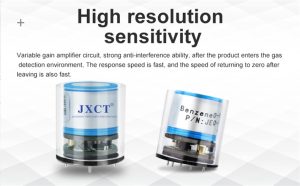In industrial environments, harmful emissions can pose significant risks to both human health and the environment. These emissions can be in the form of toxic gases, volatile organic compounds (VOCs), or other hazardous substances. Gas sensors have emerged as a crucial technology for detecting and monitoring these emissions, enabling prompt actions to minimize exposure and mitigate potential dangers. This article explores the importance of gas sensors in safeguarding industrial environments, their working principles, and the various types of gases they can detect.

Importance of Gas Sensors in Industrial Environments
Industrial processes often involve the use of chemicals, fuels, and other materials that can release harmful gases into the air. These gases can include carbon monoxide (CO), sulfur dioxide (SO2), nitrogen oxides (NOx), hydrogen sulfide (H2S), methane (CH4), and many others. Exposure to high concentrations of these gases can lead to severe health effects, such as respiratory problems, organ damage, or even death. Therefore, it is crucial to have reliable gas sensors in place to continuously monitor the air quality and provide early warning in case of gas leaks or elevated gas levels.
Gas sensors play a vital role in ensuring the safety of workers, preventing accidents, and protecting the environment. By detecting and alerting to the presence of hazardous gases, they enable swift evacuation and emergency response measures. Additionally, gas sensors help in identifying potential sources of gas emissions, allowing for remedial actions to prevent further releases and ensure a safer working environment.
Working Principles of Gas Sensors
Gas sensors work based on different detection principles, depending on the type of gas they are designed to detect. The most common types of gas sensors include electrochemical sensors, semiconductor sensors, and infrared sensors.
Electrochemical sensors utilize an electrochemical reaction between the target gas and an electrode to generate an electrical signal proportional to the gas concentration. These sensors are highly selective and sensitive, making them suitable for detecting gases like carbon monoxide and hydrogen sulfide. They require periodic calibration and replacement of the sensing element to maintain accuracy.
Semiconductor sensors rely on the change in electrical conductivity when exposed to a gas. A chemically sensitive film on the sensor's surface reacts with the target gas, altering the electrical properties of the film and generating a measurable signal. Semiconductor sensors are commonly used in the detection of combustible gases such as methane or propane. They are relatively inexpensive but can be affected by environmental factors and require regular calibration.
Infrared sensors detect gases by analyzing their absorption of specific wavelengths of infrared light. Each gas has a unique infrared absorption spectrum, allowing for precise identification and quantification. These sensors are commonly used for detecting hydrocarbons, carbon dioxide, and refrigerant gases. Infrared sensors provide accurate measurements and are less affected by cross-sensitivity to other gases.
Types of Gases Detected by Gas Sensors
Gas sensors are designed to detect various types of gases commonly found in industrial environments. Some of the most frequently monitored gases include:
Carbon Monoxide (CO): CO is a colorless and odorless gas produced by incomplete combustion of carbon-based fuels. It is highly toxic and can cause serious health problems or even death. Gas sensors equipped with electrochemical cells are commonly used for CO detection.
Hydrogen Sulfide (H2S): H2S is a toxic gas with a distinct rotten egg odor. It is produced during the decomposition of organic matter and is commonly found in oil and gas production facilities, wastewater treatment plants, and other industrial settings. Electrochemical sensors are often employed for H2S detection.

Methane (CH4): CH4 is a flammable gas and the primary component of natural gas. It poses a fire and explosion risk when present in high concentrations. Both semiconductor and infrared sensors can be used for methane detection.
Volatile Organic Compounds (VOCs): VOCs are a group of organic chemicals that can have adverse health effects and contribute to air pollution. They are emitted by various industrial processes, such as painting, printing, and chemical manufacturing. Gas sensors equipped with semiconductor technology are commonly used for VOC detection.
Oxygen (O2): Oxygen depletion or enrichment can be hazardous in certain industrial environments. Oxygen sensors are employed to monitor oxygen levels and ensure safe working conditions. These sensors are usually based on the principle of electrochemical cells.
Conclusion
Gas sensors play a critical role in safeguarding industrial environments against harmful emissions. By continuously monitoring the air quality and detecting the presence of toxic
 : +86 155 8830 2704
: +86 155 8830 2704 : jxdziot@gmail.com
: jxdziot@gmail.com
